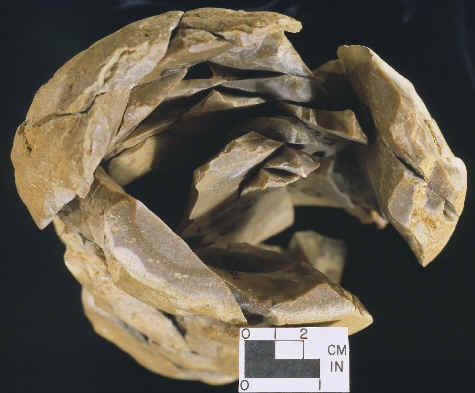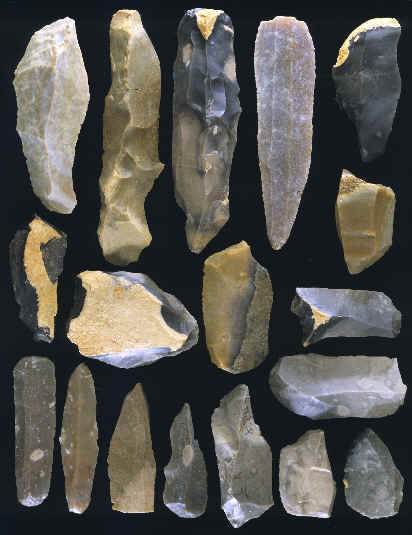|
CONTINUED
FROM PAGE 1
AURIGNACIAN
THE FIRST
MODERN HUMANS IN EUROPE
AN EARLY
UPPER
PALEOLITHIC
STONE TOOL INDUSTRY
34,000 TO 23,000 YEARS AGO
PAGE 2 OF 3
|
|

CLICK ON
PICTURE FOR VERY LARGE IMAGE
END VIEW OF A REFITTED CORE
UPPER
PALEOLITHIC---AURIGNACIAN
SOLVIEUX SITE
SOUTHERN FRANCE
This picture shows a larger view of the end of a core that was
refitted with several of its original blades. If you enlarge the
picture you will see the ends of the blades more clearly and some of
the striking platforms where they were struck off using indirect
percussion flaking. |
|
|
Archaeologists recognize the Early Upper Paleolithic period as the
beginning of the first modern humans in Europe. The Aurignacian stone tool
industry initiated a more advanced culture than ever before. The most
durable and physical evidence they left behind are the stone tools. They refined
their core and blade lithic
technology to the highest skill level that could be attained. The
Aurignacian is also recognized for its intensive use of worked antler and
bone. Some of the earliest ivory
carvings of animals and human figures begin to appear at this time. There is also widespread evidence
of long distance trade of raw materials such as fossils, shells, ivory and
stone. These materials were used to make jewelry and other pieces of art.
Even musical instruments are being made during this time. Whistles and
flutes have been found on Early Upper Paleolithic sites in Europe. |
|

CLICK ON
PICTURE FOR VERY LARGE IMAGE
MISCELLANEOUS TOOLS
UPPER
PALEOLITHIC---AURIGNACIAN
SOLVIEUX SITE
SOUTHERN FRANCE
The artifacts in this picture represent several different types of
flakes and tools belonging to the Aurignacian stone tool industry.
There are utilized blades, 2 crested blades, end scrapers, side
scrapers and burins. Most of these artifacts were made from complete, broken
or resharpened pieces of core blades. |
|
|
The
Aurignacian stone tool industry invented the most efficient way to remove long narrow
flakes from a piece of stone. The previous Middle Paleolithic Mousterian stone tool industry
produced more waste flakes during the production of flake tools.
Aurignacian technology invented a more thrifty and efficient flake removal
system. One important advantage of this technology was that it allowed
these hunter-gatherer people to carry less material & weight. |
|

CLICK ON
PICTURE FOR VERY LARGE IMAGE
BLADE
UPPER
PALEOLITHIC----AURIGNACIAN
SOLVIEUX SITE
SOUTHERN FRANCE
This is an excellent example of a core blade from the Aurignacian
stone tool industry. It shows very little use wear but
enough to indicate that it was probably used for some type of
cutting or scraping job. Three long flake scars can be seen from
previous
blade removals. This blade is made from good quality
chert and it measures 4 1/8 inches (104mm) long. |
|
|
It's
generally believed by archaeologists that most Upper Paleolithic
blades were removed by indirect percussion flaking. This technique allows
for a more precise placement of the flaking tool when the hammer strikes
off a blade. This process is similar to the use of today's hammer and
chisel. |
|

CLICK ON
PICTURE FOR LARGER IMAGE
A
CAST OF THIS BLADE TOOL IS AVAILABLE
DOUBLE END SCRAPER
UPPER
PALEOLITHIC----AURIGNACIAN
TEMPO-PIALAT SITE
COUZE VALLEY IN SOUTHERN FRANCE
UNIVERSITY OF KANSAS, MUSEUM OF ANTHROPOLOGY
This is an excellent example of a blade tool from the Aurignacian
stone tool industry. It was not resharpened except for its initial
trimming of both ends for scrapers and some edge trimming along
three fourths of one edge. This blade tool could have been used for
either scraping or cutting. It was made from a good quality white
chert and it measures 4 3/4 inches (12cm) long and 1 3/16 inches
(3cm) wide. |
|
|
The
most common blade tools made during the European Upper Paleolithic were
burins, end scrapers and backed blades or knives. A burin as defined in
the dictionary is basically an instrument or tool for engraving metal or
stone. Several
different types of burins are represented within the Aurignacian stone
tool industry. The definition of each type depends on what angle and how many burin
flake removals (edge removals) were used to shape the end of a single blade.
They all have a sturdy chisel-like
edge that could be used to cut or engrave materials like bone, ivory or
wood. |
|
CONTINUE ON TO PAGE THREE
|
|
"REFERENCES"
1970, "Tools of the Old Stone Age," by Jacques Bordaz.
1973, "The Old Stone Age," by Francois Bordes.
1988, "Encyclopedia of Human Evolution & Prehistory," by Ian
Tattersall, Eric Delson & John Van Couvering.
1991, "The Roots of Civilization," by Alexander Marshack.
1993, "Handbook of Paleolithic Typology, Vol. I," by Andre
Debenath and Harold L. Dibble.
1993, "Making Silent Stones Speak," by Kathy D. Schick and
Nicholas Toth.
|
|
HOME
ORDERING |



